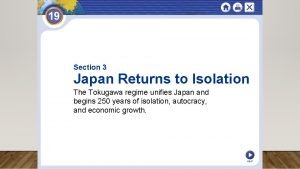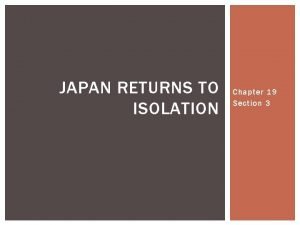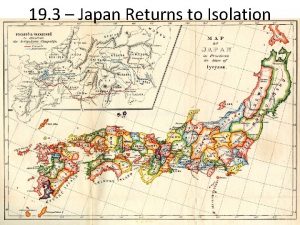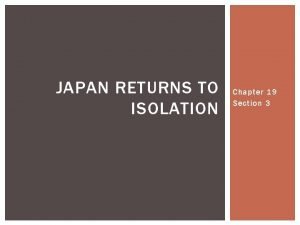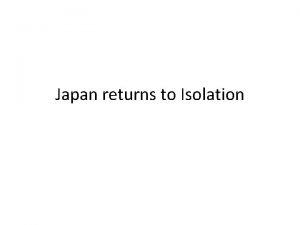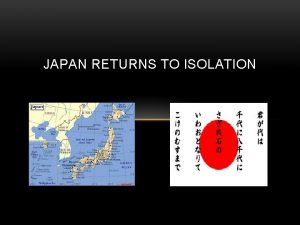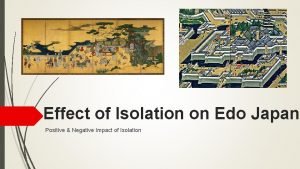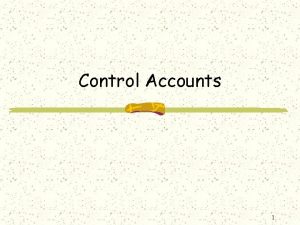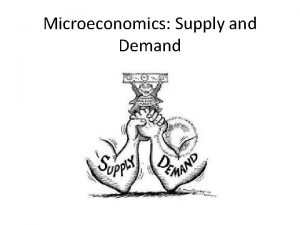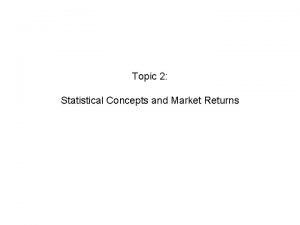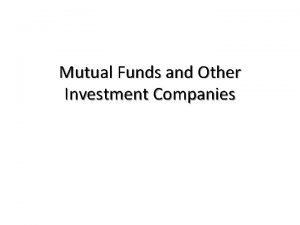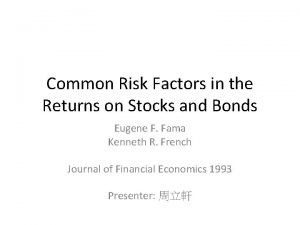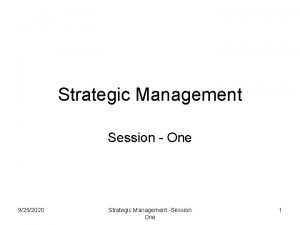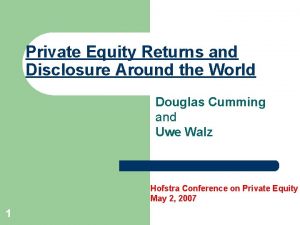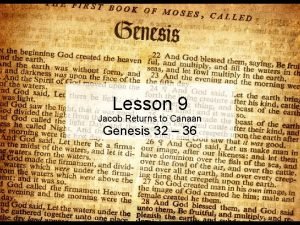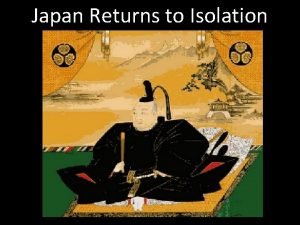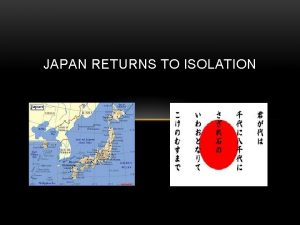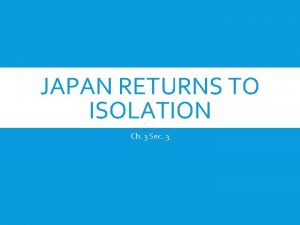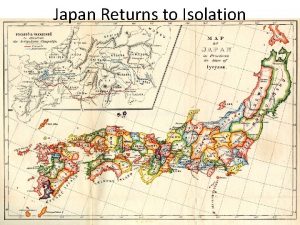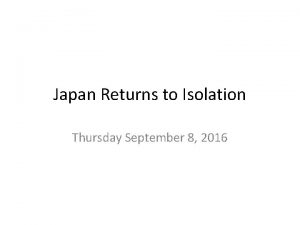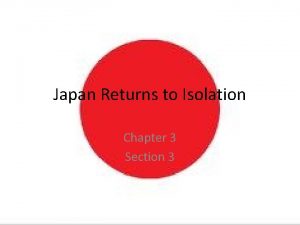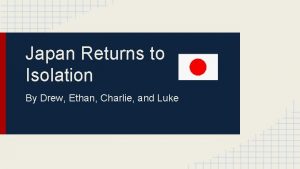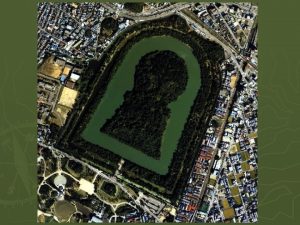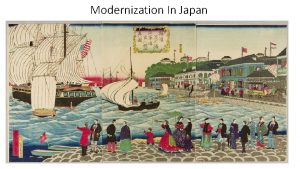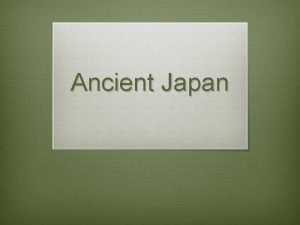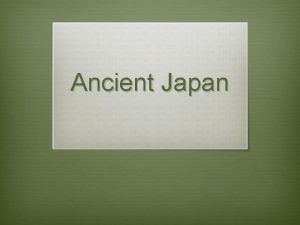Ch 3 3 Japan Returns to Isolation Terms







![Catholic Jesuits in Japan St. Francis Xavier [First Catholic Missionaries in Asia] Catholic Jesuits in Japan St. Francis Xavier [First Catholic Missionaries in Asia]](https://slidetodoc.com/presentation_image_h2/6d4afe72e679821cc090411b883559e9/image-8.jpg)





















- Slides: 29

Ch. 3: 3: Japan Returns to Isolation Terms & Names Daimyo Oda Nobunaga Toyotomi Hideyoshi Tokugawa Shogunate Haiku Kabuki Questions Which contribution by a daimyo was the most significant? Why? What happened during the period of the warring states? What was the structure of society in Tokugawa Japan? What were the new styles of drama, art, and literature in Tokugawa Japan? Why did the Japanese policy towards Christians change from acceptance to repression? What was the “closed-country policy” and how did it affect Japan?

SETTING THE STAGE In the 1300 s, the unity that had been achieve in Japan in the previous century broke down Shoguns, or military leaders, in the north and south fiercely fought one another for power. It would be centuries before Japan would again be unified

Ashikaga Age: 1338 -1573 ► Shoguns fought for power. Laws are unclear. Less efficient than the Kamakura. Armies of samurai protected the country.

Warring states period “Sengoku” 1467 -1568 Samurai seized control of feudal estates Offered peasants and others protection for loyalty Warrior chieftains, called daimyo, lords in a new kind of Japanese feudalism Daimyo means “great name” Emperor at Kyoto became a figurehead.

Oda Nobunaga (1534 -1582) Banishes the last Ashikaga shogun. Unifies a large part of Japan.

Oba Nobunaga Many daimyo hoped to gather power to take control of country 1568 seized imperial capital of Kyoto “Rule the empire by force” 1575, Nobunaga’s 3, 000 soldiers armed with muskets crushed an enemy force of samurai cavalry. He did not unify Japan Committee seppuku – the ritual suicide of a samurai, when one of his own generals turned on him

Seppuku: Ritual Suicide It is honorable to die in this way. Kaishaku – his “seconds”
![Catholic Jesuits in Japan St Francis Xavier First Catholic Missionaries in Asia Catholic Jesuits in Japan St. Francis Xavier [First Catholic Missionaries in Asia]](https://slidetodoc.com/presentation_image_h2/6d4afe72e679821cc090411b883559e9/image-8.jpg)
Catholic Jesuits in Japan St. Francis Xavier [First Catholic Missionaries in Asia]

Toyotomi Hideyoshi (1536 -1598) Becomes suspicious of European territorial ambitions. Orders all European missionaries expelled from Japan. Tries to invade Korea, but fails.

Toyotomi Hideyoshi Nobunaga’s best general Mission to conquer rivals and unify Japan with brute force and political alliances By 1590, controlled most of the country Invaded Korea in 1592 and began long campaign against Koreans and Ming Chinese allies

Tokugawa Shogunate Tokugawa Ieyasu, one of Hideyoshi’s strongest allies, unified Japan In 1600, defeated rivals at the Battle of Sekigahara-earned him loyalty of of all daimyo Became the sole ruler or shogun Moved capital to Edo (later Tokyo) To keep loyalty used “alternate attendance policy” Spend every other year in Edo Leave their families there the years they left

Tokugawa Ieyasu (1543 -1616) Appointed shogun by the Emperor. Four-class system laid down with marriage restricted to members of the same class! Warriors. Farmers. Artisans. Merchants.

Tokugawa Shogunate Period Japan closed off to all trade [except to the Dutch and Chinese]. The Dutch were restricted to a small island in Nagasaki harbor. Japanese Christians persecuted and Christianity is forbidden. The government is centralized with all power in the hands of the shogun. Domestic trade flourishes. Towns, esp. castle towns, increase. Merchant class becomes rich! New art forms haiku poetry, kabuki theater.

Japanese culture- haiku 5 -7 -5 syllable, 3 -line verse poetry Matsuo Basho-greates poet wrote before he died 1694 One a journey, ailing My dreams roam about Over a withered moor

Haiku : 17 -syllable poem Spring departs. Birds cry Fishes' eyes are filled with tears. Matsuo Basho, Master of Haiku

Japanese culture- kabuki Theater Actors in elaborate costumes, using music, dance, and mime, performed skits abut modern life.

The emperor reigned, but did not always rule! Feudal Society

Feudalism A political, economic, and social system based on loyalty, the holding of land, and military service. Japan: Shogun Land - Shoen Protection Daimyo Samurai Peasant Loyalty Samurai Peasant Food Peasant

Underpinnings: Basic Steps in Self Defense A COTTON BREECH CLOUT that extended up over the chest was the basic undergarment of a samurai’s costume A SHORT SLEEVED KIMONO, KIMONO or “armor robe, ” was tied snugly at the waist with a special knot (lower right)

Feudalism A political, economic, and social system based on loyalty, the holding of land, and military service. Europe: King Land - Fief Lord Land - Fief Protection Knight Peasant Loyalty Lord Knight Peasant Loyalty Knight Peasant Food Peasant

Zen Buddhism A Japanese variation of the Mahayana form of Buddhism, which came from India through China. It reinforced the Bushido values of mental and self-discipline.

Contact Between Europe and Japan Shipwrecked Portuguese washed up in 1543 (during Warring States)-merchants soon followed Portuguese brought clocks, eyeglasses, tobacco, and FIREARMS Japanese merchants and daimyo welcomed them- especially for muskets and cannons Japanese purchases weapons and soon began own production-fall of Samurai Cannons effects- building of strong castles

Christian Missionaries In 1549, missionaries began arriving At first Japanese accepted them-associated with muskets and goods Many Jesuits, Franciscans, and Dominicans came to convert the Japanese Francis Xavier led first mission. By 1600, missionaries had converted about 300, 000 Japanese to Christianity Success upset Tokugawa Ieyasu

Christian Missionaries Ieyasu died in 1616, but repression of Christianity continued off and on for 20 years In 1637, pursing of some 30, 000 peasant led by dissatisfied samurai, because so many rebels were Christian, Shogun decided Christianity was at the root of the rebellion After that, shoguns ruthlessly persecute Christian Missionaries scorned traditional Japanese beliefs Sometimes involved themselves in local politics At first, no action not to disturb trade, then by 1612, shogun had come to fear religious uprisings more Banned Christianity and focused on ridding his country of all Christians. All Japanese were force to demonstrate faithfulness to some branch of Buddhism

What were the new styles of drama, art, and literature in Tokugawa Japan? Kabuki theater Woodblock printing Urban fiction Haiku poetry

Why did the Japanese policy towards Christians change from acceptance to repression? Tokugawa leaders believe Christian scorned traditional beliefs, and this might have led to rebellion

What was the “closed-country policy” and how did it affect Japan? It closed off foreign access to Japan For more than 200 years, Japan existed as a self-sufficient country with only one port (Nagasaki) remaining open to foreign (Dutch and Chinese) traders Due to the repression of Christianity and persecution of Christians, Christianity was virtually eliminated in Japan All Japanese were required to demonstrate faithfulness to Buddhism Japan remained free from European attempt to colonize or to establish a presence in Japan The Tokugawa Shogunate grew rich from its monopoly on foreign trade

Why might Europeans have been more eager to trade with China and Japan during this time that China and Japan were to trade with Europe? EUROPEANS: Not content just to trade goods, wanted to dominate their trading partners to get wealthy Wanted to convert them to Christianity JAPANESE-CHINESE They did not feel need to convert others to their religions Japanese-Chinese were already trading with each other, goods from Europe not as enticing to Asians as Asian goods to the Europeans China had ancient –sophisticated civilization, saw itself as self-sufficient and central to the world, IT DID NOT NEED TO SEEK OUT TRADE BECAUSE IT DIDN’T NEED ANYTHING Chinese had long history of invasion, made them suspicious of foreigners and protective of their cultural traditions.

Why might China’s reaction to trading with Europeans differed from Japan’s initial reaction to European trade? How did these attitudes change over time? JAPAN CHINA Daimyo also welcoming and interested in the firearms and cannons China believed itself to be the center of the world, advanced, self-sufficient At time, Japan lacked a strong central authority to contain the Europeans or make any decision how to deal with them or trade Emperor was quick to realized that along with trade came outside influences, which were not welcome First encountered shipwrecked Portuguese in 1543 on shores of southern Japan, merchants soon followed Government did not support commerce because it went against China’s Confucian beliefs. Japanese merchants eager to expand their markets and receive the European goods Ming Dynasty had been strong for more than a century by the time the first Europeans arrived. Over time Japan accepted the merchants and missionaries until the 1600 s. by this time, Tokugawa Ieyasu and taken power in Japan and centralized Agriculture was favored and taxed less, commerce and trade taxed higher Over time By 1639, Japan sealed its borders and instituted a “closed country” policy China did not change its attitude and continued its policy of isolation through the Qing Dynasty The success of the European missionaries bothered him because they began to become involved in politics, and he feared an uprising The Dutch were the only Europeans to be allowed to trade with China because the Dutch kowtowed and paid tribute The strong leaders under Tokugawa did not like the introduction of European ideas and ways The Chinese, felt that their country was self-sufficient, and they would remain isolated for centuries
 Japan returns to isolation
Japan returns to isolation Chapter 19 section 3 japan returns to isolation
Chapter 19 section 3 japan returns to isolation Japan civil war 1467
Japan civil war 1467 Chapter 19 section 3 japan returns to isolation
Chapter 19 section 3 japan returns to isolation Japan returns to isolation
Japan returns to isolation Japan returns to isolation
Japan returns to isolation Did isolation have a positive or negative effect on japan?
Did isolation have a positive or negative effect on japan? What are the like terms in the algebraic expression
What are the like terms in the algebraic expression Like terms and unlike terms in polynomials
Like terms and unlike terms in polynomials The law of accelerating returns
The law of accelerating returns Control account purpose
Control account purpose Law of demand
Law of demand Statistical concepts and market returns
Statistical concepts and market returns Perpetual inventory system sales returns
Perpetual inventory system sales returns How to calculate abnormal returns
How to calculate abnormal returns Mutual fund returns may be granted pass-through status if
Mutual fund returns may be granted pass-through status if Stage of negative returns
Stage of negative returns An nfa’s transition function returns
An nfa’s transition function returns Law of diminishing returns
Law of diminishing returns Common risk factors in the returns on stocks and bonds
Common risk factors in the returns on stocks and bonds Mean deviation formula
Mean deviation formula Return outwards in profit and loss account
Return outwards in profit and loss account Resource based model
Resource based model An algorithm that returns near optimal solution is called
An algorithm that returns near optimal solution is called Private equity returns and disclosure around the world
Private equity returns and disclosure around the world Seir succoth shechem map
Seir succoth shechem map The function sum( region= sales) returns
The function sum( region= sales) returns Dell return center
Dell return center Point of diminishing returns calculus
Point of diminishing returns calculus Sales discounts income statement
Sales discounts income statement
